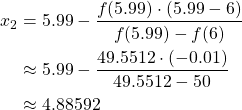44 Secant Rule
The Secant Rule is an alternative to the Newton-Raphson method that does not require that we find the first derivative [9]. The benefit of the Secant Rule is that we can use it when the derivative would be difficult to find. However, the drawback is that this rule may take a few more iterations than the Newton-Raphson method to get to the same answer [9]. The Secant Rule formula is given by Hiestand as follows [9]:
![]()
The reasoning behind the Secant Rule is that we approximate the derivative rather than find the exact derivative function. Recall from Part I: Chapter 2 that the definition of the derivative of a function ![]() is
is
![]()
First, we let ![]() and
and ![]() [9]. Then we have
[9]. Then we have
![]()
Finally, we substitute ![]() into the Newton-Raphson equation [9].
into the Newton-Raphson equation [9].

Now we have our formula for the Secant Rule. Notice that with this formula we need two starting values as opposed to just one. A good way to find these values is to find the starting value that we would use for the Newton-Raphson method. Then pick another number that is very close to that starting value.
Let’s now work through an example demonstrating this rule. This problem is one I completed for this paper and comes from Hiestand [9].
Consider the equation
Solution
For ![]() ,
, ![]() and
and ![]() It follows that
It follows that ![]() for
for ![]() . This means that any root would have to be less than six. So, we will let
. This means that any root would have to be less than six. So, we will let ![]() and
and ![]() Our first three iterations are then
Our first three iterations are then



After three iterations,
![]()
Because

we are getting closer to a root with each iteration so ![]() and
and ![]() were good choices.
were good choices.
If we continued on, we would eventually reach our root. But since we understand how the Secant Rule works, let’s move on to our last topic, Gaussian-Seidel Iteration.
